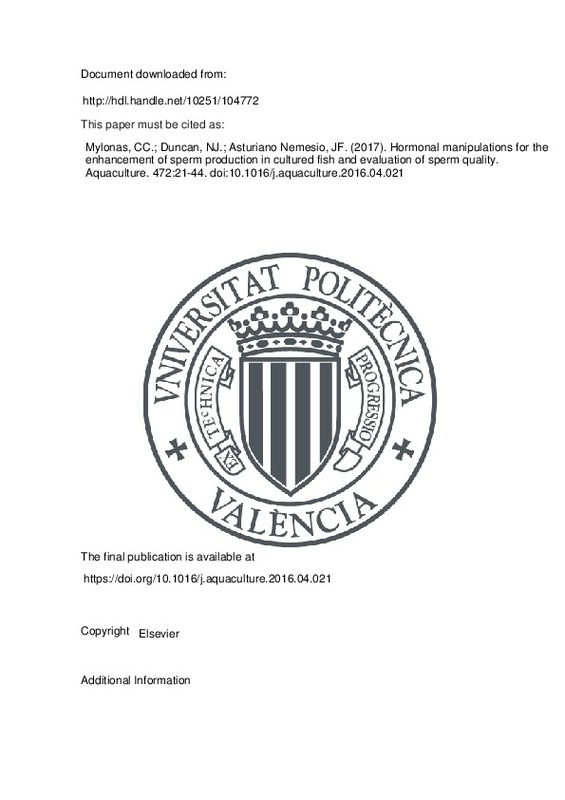JavaScript is disabled for your browser. Some features of this site may not work without it.
Buscar en RiuNet
Listar
Mi cuenta
Estadísticas
Ayuda RiuNet
Admin. UPV
Hormonal manipulations for the enhancement of sperm production in cultured fish and evaluation of sperm quality
Mostrar el registro sencillo del ítem
Ficheros en el ítem
| dc.contributor.author | Mylonas, Constantinos C.
|
es_ES |
| dc.contributor.author | Duncan, Neil J.
|
es_ES |
| dc.contributor.author | Asturiano Nemesio, Juan Francisco
|
es_ES |
| dc.date.accessioned | 2018-06-28T08:20:05Z | |
| dc.date.available | 2018-06-28T08:20:05Z | |
| dc.date.issued | 2017 | es_ES |
| dc.identifier.issn | 0044-8486 | es_ES |
| dc.identifier.uri | http://hdl.handle.net/10251/104772 | |
| dc.description.abstract | [EN] This article reviews the use of hormonal treatments to enhance sperm production in aquaculture fish and the methods available for evaluating sperm quality. The different types of testis development are examined and a brief review is presented of the endocrine regulation of spermatogenesis in fishes, including the increasing evidence of the existence of spermatozoa subpopulations. Hormonal manipulations are employed to induce spermatogenesis in species such as the freshwater eels, to synchronize maximal sperm volume to ovulation for in vitro fertilization and to enhance sperm production in species with poor spermiation. The hormones that are employed include gonadotropins (GtHs) of piscine or mammalian origin, and gonadotropin-releasing hormone agonists (GnRHa) administered by injections or controlled-release delivery systems, with or without dopaminergic inhibitors. Pheromones in the culture water and hormones added to the sperm in vitro have also been employed to enhance spermiation and sperm quality, respectively, in some fishes. Hormonal therapies usually do not affect sperm quality parameters, except in cases where fish fail to spermiate naturally or produce very small volumes of high-density sperm. Different parameters have been used to evaluate fish sperm quality, including sperm volume and density, spermatozoa motility and morphometry, and seminal plasma composition. The development of Computer-Assisted Sperm Analysis (CASA) systems made possible the estimation of a higher number of sperm motion parameters using an objective, sensitive and accurate technique. The development of Assisted Sperm Morphology Analysis (ASMA) software has introduced a new approach for sperm evaluation studies, demonstrating changes in the spermatozoa related to reproductive season, hormonal treatments or the cryopreservation processes, and how these may be related to changes in sperm motility and fertilization capacity. The article concludes with a few practical protocols for the enhancement of sperm production in aquaculture species. | es_ES |
| dc.description.sponsorship | We would like to thank the COST Action FA1205 (AQUAGAMETE) titled “Assessing and improving the quality of aquatic animal gametes to enhance aquatic resources - The need to harmonize and standardize evolving methodologies, and improve transfer from academia to industry” for initiating the production of this special issue and funding partially this article. JFA has been partly funded by the Spanish Ministry of Economy and Competitiveness (REPRO-TEMP; AGL2013-41646-R) and the European Training Network IMPRESS (Marie SklodowskaCurie Actions; Grant agreement n°: 642893). ND has been funded partly by the INIA-FEDER project RTA2011-00050, and CCM and ND have been supported also by the EU project DIVERSIFY (7FP-KBBE-2013-GA 602131). | |
| dc.language | Inglés | es_ES |
| dc.publisher | Elsevier | es_ES |
| dc.relation.ispartof | Aquaculture | es_ES |
| dc.rights | Reserva de todos los derechos | es_ES |
| dc.subject | Spermiation | es_ES |
| dc.subject | Broodstock management | es_ES |
| dc.subject | Sperm enhancement | es_ES |
| dc.subject | Sperm quality | es_ES |
| dc.subject.classification | PRODUCCION ANIMAL | es_ES |
| dc.title | Hormonal manipulations for the enhancement of sperm production in cultured fish and evaluation of sperm quality | es_ES |
| dc.type | Artículo | es_ES |
| dc.identifier.doi | 10.1016/j.aquaculture.2016.04.021 | es_ES |
| dc.relation.projectID | info:eu-repo/grantAgreement/MINECO//AGL2013-41646-R/ES/LA ANGUILA EUROPEA COMO MODELO PARA ESTUDIAR LA TEMPERATURA COMO MODULADOR DE LA MADURACION SEXUAL EN TELEOSTEOS. POTENCIAL APLICACION EN ACUICULTURA./ | es_ES |
| dc.relation.projectID | info:eu-repo/grantAgreement/EC/FP7/602131/EU/Towards a Sustainable and Affordable Healthcare/ | es_ES |
| dc.relation.projectID | info:eu-repo/grantAgreement/MICINN//RTA2011-00050/ | es_ES |
| dc.relation.projectID | info:eu-repo/grantAgreement/EC/H2020/642893/EU/Improved production strategies for endangered freshwater species./ | es_ES |
| dc.rights.accessRights | Abierto | es_ES |
| dc.date.embargoEndDate | 2019-04-01 | es_ES |
| dc.contributor.affiliation | Universitat Politècnica de València. Departamento de Ciencia Animal - Departament de Ciència Animal | es_ES |
| dc.description.bibliographicCitation | Mylonas, CC.; Duncan, NJ.; Asturiano Nemesio, JF. (2017). Hormonal manipulations for the enhancement of sperm production in cultured fish and evaluation of sperm quality. Aquaculture. 472:21-44. https://doi.org/10.1016/j.aquaculture.2016.04.021 | es_ES |
| dc.description.accrualMethod | S | es_ES |
| dc.relation.publisherversion | https://doi.org/10.1016/j.aquaculture.2016.04.021 | es_ES |
| dc.description.upvformatpinicio | 21 | es_ES |
| dc.description.upvformatpfin | 44 | es_ES |
| dc.type.version | info:eu-repo/semantics/publishedVersion | es_ES |
| dc.description.volume | 472 | es_ES |
| dc.relation.pasarela | S\315800 | es_ES |
| dc.contributor.funder | European Commission | es_ES |
| dc.contributor.funder | Ministerio de Economía y Competitividad | es_ES |
| dc.contributor.funder | Ministerio de Ciencia e Innovación | es_ES |







![[Cerrado]](/themes/UPV/images/candado.png)

